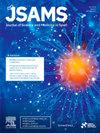英超青训球员的神经肌肉疲劳:赛季内和跨赛季反应。
IF 3
2区 医学
Q1 SPORT SCIENCES
引用次数: 0
摘要
目的:探讨英超U-18青训球员在赛季内和跨赛季的神经肌肉疲劳反应。设计:来自同一队的25名球员在一个完整的比赛赛季中完成了每周的反动作跳跃和等长内收肌和后链力量测试。方法:每天记录全球定位系统测量的训练和比赛总量、高代谢负荷和冲刺距离,并将其转换为指数加权的7天和28天的移动平均值。结果:TD28 (p 28 (p 28)(p = .002)与反动作跳高呈负相关,但不存在主要的跨季节影响(p = .137)。TD28 (p = .016)和HML28 (p = .012)积极与等距后链强度但没有SD28效应(p = .653),SD7 (p = .549),TD7 (p = .080)或HML7 (p = .104)。跨赛季,等长后链强度遵循曲线响应,即表现在赛季开始时增加,在赛季结束时下降(p = .003)。训练负荷或时间对等长内收肌力量表现没有影响(p > .094)。结论:随着训练和比赛负荷的持续变化,神经肌肉状态随着反动作跳跃高度的变化而波动,但没有证据表明主要的跨季节线性效应。总训练量和比赛量对内部训练负荷剂量有调节作用,反过来,对神经肌肉疲劳有重要的调节作用,特别是当由高强度和冲刺距离组成的大量运动时。在赛季结束时,后链可能特别容易疲劳。本文章由计算机程序翻译,如有差异,请以英文原文为准。
Neuromuscular fatigue in English Premier League academy football players: Within- and cross-season responses
Objectives
To examine the within- and cross-season neuromuscular fatigue responses in English Premier League U-18 academy football players.
Design
Twenty-five players from the same team completed weekly countermovement jump and isometric adductor and posterior chain strength tests for a full competitive season.
Methods
Global positioning system measures of training and match total, high-metabolic load and sprint distance were recorded daily and converted into exponentially weighted moving average seven- and twenty-eight-day values.
Results
TD28 (p < .001), HML28 (p < .001), and SD28 (p = .002) shared negative relationships with countermovement jump height, but there was no main cross-season effect (p = .137). TD28 (p = .016) and HML28 (p = .012) positively related to isometric posterior chain strength but there was no effect of SD28 (p = .653), SD7 (p = .549), TD7 (p = .080) or HML7 (p = .104). Cross season, isometric posterior chain strength followed a curvilinear response whereby performance increased across the beginning of the season and decreased towards the end of the season (p = .003). There was no effect of training load or time on isometric adductor strength performance (p > .094).
Conclusions
Neuromuscular status, signalled by countermovement jump height changes fluctuates across the season in response to sustained changes in training and match load, but there is no evidence of a main cross-season linear effect. Total training and match volume exert moderating effects on the internal training load dose, and in-turn, important moderating effects on neuromuscular fatigue, particularly when composed of high volumes of high-intensity and sprint distances. The posterior chain might be particularly susceptible to fatigue towards the end of the season.
求助全文
通过发布文献求助,成功后即可免费获取论文全文。
去求助
来源期刊
CiteScore
7.40
自引率
10.00%
发文量
198
审稿时长
48 days
期刊介绍:
The Journal of Science and Medicine in Sport is the official journal of Sports Medicine Australia (SMA) and is an an international refereed research publication covering all aspects of sport science and medicine.
The Journal considers for publication Original research and Review papers in the sub-disciplines relating generally to the broad sports medicine and sports science fields: sports medicine, sports injury (including injury epidemiology and injury prevention), physiotherapy, podiatry, physical activity and health, sports science, biomechanics, exercise physiology, motor control and learning, sport and exercise psychology, sports nutrition, public health (as relevant to sport and exercise), and rehabilitation and injury management. Manuscripts with an interdisciplinary perspective with specific applications to sport and exercise and its interaction with health will also be considered.

 求助内容:
求助内容: 应助结果提醒方式:
应助结果提醒方式:


